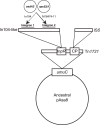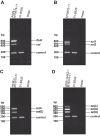Diversity of antibiotic-resistance genes in Canadian isolates of Aeromonas salmonicida subsp. salmonicida: dominance of pSN254b and discovery of pAsa8
- PMID: 27752114
- PMCID: PMC5067588
- DOI: 10.1038/srep35617
Diversity of antibiotic-resistance genes in Canadian isolates of Aeromonas salmonicida subsp. salmonicida: dominance of pSN254b and discovery of pAsa8
Abstract
The bacterium Aeromonas salmonicida subsp. salmonicida is a common pathogen in fish farms worldwide. Since the antibiotic resistance of this bacterial species is on the increase, it is important to have a broader view on this issue. In the present study, we tested the presence of known plasmids conferring multi-drug resistance as well as antibiotic resistance genes by a PCR approach in 100 Canadian A. salmonicida subsp. salmonicida isolates. Our study highlighted the dominance of the conjugative pSN254b plasmid, which confers multi-drug resistance. We also identified a new multi-drug plasmid named pAsa8, which has been characterized by a combination of sequencing technologies (Illumina and Oxford nanopore). This new plasmid harbors a complex class 1 integron similar to the one of the Salmonella genomic island 1 (SGI1) found in Salmonella enterica and Proteus mirabilis. Consequently, in addition to providing an update on the A. salmonicida subsp. salmonicida isolates that are resistant to antibiotics, our data suggest that this bacterium is potentially an important reservoir of drug resistance genes and should consequently be monitored more extensively. In addition, we describe a screening method that has the potential to become a diagnostic tool that is complementary to other methods currently in use.
Figures




Similar articles
-
Detection of variants of the pRAS3, pAB5S9, and pSN254 plasmids in Aeromonas salmonicida subsp. salmonicida: multidrug resistance, interspecies exchanges, and plasmid reshaping.Antimicrob Agents Chemother. 2014 Dec;58(12):7367-74. doi: 10.1128/AAC.03730-14. Epub 2014 Sep 29. Antimicrob Agents Chemother. 2014. PMID: 25267667 Free PMC article.
-
One Aeromonas salmonicida subsp. salmonicida isolate with a pAsa5 variant bearing antibiotic resistance and a pRAS3 variant making a link with a swine pathogen.Sci Total Environ. 2019 Nov 10;690:313-320. doi: 10.1016/j.scitotenv.2019.06.456. Epub 2019 Jun 28. Sci Total Environ. 2019. PMID: 31299566
-
Variants of a genomic island in Aeromonas salmonicida subsp. salmonicida link isolates with their geographical origins.Vet Microbiol. 2015 Jan 30;175(1):68-76. doi: 10.1016/j.vetmic.2014.11.014. Epub 2014 Nov 22. Vet Microbiol. 2015. PMID: 25480167
-
The Aeromonas salmonicida plasmidome: a model of modular evolution and genetic diversity.Ann N Y Acad Sci. 2021 Mar;1488(1):16-32. doi: 10.1111/nyas.14503. Epub 2020 Oct 10. Ann N Y Acad Sci. 2021. PMID: 33040386 Review.
-
Virulence, genomic features, and plasticity of Aeromonas salmonicida subsp. salmonicida, the causative agent of fish furunculosis.Vet Microbiol. 2014 Feb 21;169(1-2):1-7. doi: 10.1016/j.vetmic.2013.06.025. Epub 2013 Jul 9. Vet Microbiol. 2014. PMID: 23890675 Review.
Cited by
-
New Structure of Aeromonas salmonicida O-Polysaccharide Isolated from Ill Farmed Fish.Microorganisms. 2024 Aug 1;12(8):1575. doi: 10.3390/microorganisms12081575. Microorganisms. 2024. PMID: 39203417 Free PMC article.
-
A continuously changing selective context on microbial communities associated with fish, from egg to fork.Evol Appl. 2020 Jun 9;13(6):1298-1319. doi: 10.1111/eva.13027. eCollection 2020 Jul. Evol Appl. 2020. PMID: 32684960 Free PMC article.
-
Susceptibility to Bismuth(III) of Aquaculture Bacterial Pathogens: Effectiveness of Bismuth-Deferiprone Therapy against Vibrio anguillarum Infection in Fish.Microorganisms. 2021 Nov 21;9(11):2399. doi: 10.3390/microorganisms9112399. Microorganisms. 2021. PMID: 34835524 Free PMC article.
-
Characterization of bacteriophage T7-Ah reveals its lytic activity against a subset of both mesophilic and psychrophilic Aeromonas salmonicida strains.Arch Virol. 2021 Feb;166(2):521-533. doi: 10.1007/s00705-020-04923-w. Epub 2021 Jan 4. Arch Virol. 2021. PMID: 33394168
-
MQM1, a bacteriophage infecting strains of Aeromonas salmonicida subspecies salmonicida carrying Prophage 3.Virus Res. 2023 Sep;334:199165. doi: 10.1016/j.virusres.2023.199165. Epub 2023 Jun 30. Virus Res. 2023. PMID: 37385348 Free PMC article.
References
-
- Hiney M. & Olivier G. In Fish diseases and disorders, vol III: viral, bacterial and fungal infections (eds Woo P. T. K. & Bruno D. W.) 341–425 (CAB publishing Oxford, 1999).
-
- Morin R. L’utilisation des antibiotiques pour combattre la furonculose chez l’omble de fontaine génère de l’antibiorésistance chez Aeromonas salmonicida. L’aquicole 15, 2–6 (2010).
Publication types
MeSH terms
Substances
LinkOut - more resources
Full Text Sources
Other Literature Sources
Medical
Molecular Biology Databases

